Art, Wealth, Strategy, and Ego Beyond Transactions
In the world of art, where creative expression thrives and aesthetic experiences abound, lies an intricate intersection with finance, wealth transfer, and strategic maneuvering. Art Basel Miami, a vibrant stage where global collectors and investors converge, serves as an entryway into this complex dance of wealth movement.
Art acquisitions aren't merely about procuring beautiful creations; they represent a strategic maneuver in the global chessboard of wealth transfer. The beauty of the art market lies in its lack of strict regulations, offering a discreet avenue for moving substantial sums across borders, evading the intricate oversight of traditional financial transactions.
Yet, as we embrace the allure of Art Basel Miami, it's crucial to acknowledge the broader canvas beneath. This unregulated terrain raises pertinent questions about transparency, regulation, and potential vulnerabilities, hinting at concerns like money laundering or circumventing financial oversight.
This convergence of art and finance in Art Basel Miami transcends the admiration for art and becomes a conduit for wealth transfer—particularly notable for affluent South Americans seeking international wealth diversification. The city's geographical significance in connecting South America with the US elevates its role as a gateway for discreetly transferring wealth through art acquisitions.
However, among the passionate collectors, art aficionados, and patrons supporting galleries or artists lies a deeper narrative—an intricate tapestry of motivations and strategies. The use of art as a tool for wealth transfer subtly shapes the landscape, allowing for discreet capital movement amid cultural celebrations and financial strategies.
Peel back the layers, and you'll uncover stories of passion, ambition, ego, and philanthropy entwined in the art market's fabric. This nuanced narrative intertwines financial strategies, cultural aspirations, and the delicate balance between discretion and regulatory compliance.
In the grand stage of the art market, where each stroke tells a story, Miami's significance emerges beyond its prestigious events. It's a geographical pivot, enabling a captivating tale of wealth transfer and financial intrigue—a story that unfolds with every acquisition and resonates within the intricate framework of the art market's unregulated landscape.
what makes the art market appear unregulated?
The art market's perceived lack of regulation compared to traditional financial markets can be attributed to several key reasons:
Secrecy and Opacity: A significant portion of art transactions occurs discreetly, away from public scrutiny. This veil of secrecy complicates tracking real prices and understanding the movement of money, leading to price fluctuations without clear explanations.
Varied Pricing Dynamics: Unlike conventional markets where prices reflect demand and supply, art prices are influenced by subjective factors like an artist's fame or prevailing trends. This subjectivity challenges the establishment of standardized pricing, adding to the perception of an unregulated market.
Lack of Centralized Oversight: Unlike financial markets governed by regulatory bodies, the art market lacks a single overarching authority. This decentralized oversight presents challenges in addressing issues like fraud or unethical financial practices.
Complexity Across Borders: Operating globally introduces complexities with varying legal systems and cultural norms, making uniform regulations difficult to enforce. This global nature creates gaps in supervision and standardization.
Legal Maneuvering: Certain legal strategies, like utilizing offshore entities, enable privacy or circumvent specific regulations in the art market. These legal loopholes allow practices that wouldn't be feasible in more regulated financial sectors.
The amalgamation of these factors contributes to the perception of a less regulated art market, providing a level of privacy and flexibility. However, this freedom also raises concerns about transparency and accountability. Efforts are ongoing to enhance transparency and address regulatory gaps to improve oversight and accountability within the art market.








